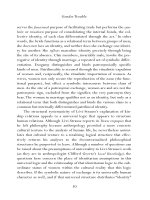GENDER TROUBLE 112
Bạn đang xem bản rút gọn của tài liệu. Xem và tải ngay bản đầy đủ của tài liệu tại đây (20.56 KB, 1 trang )
Prohibition, Psychoanalysis, and the Heterosexual Matrix
found.At the close of his brief paragraph on the negative Oedipal complex in the young girl, Freud remarks that the factor that decides
which identification is accomplished is the strength or weakness of
masculinity and femininity in her disposition. Significantly, Freud
avows his confusion about what precisely a masculine or feminine disposition is when he interrupts his statement midway with the hyphenated doubt: “—whatever that may consist in—” (22).
What are these primary dispositions on which Freud himself apparently founders? Are these attributes of an unconscious libidinal organization, and how precisely do the various identifications set up in
consequence of the Oedipal conflict work to reinforce or dissolve each
of these dispositions? What aspect of “femininity” do we call dispositional, and which is the consequence of identification? Indeed, what is to
keep us from understanding the “dispositions” of bisexuality as the effects
or productions of a series of internalizations? Moreover, how do we identify a “feminine” or a “masculine” disposition at the outset? By what
traces is it known, and to what extent do we assume a “feminine” or a
“masculine” disposition as the precondition of a heterosexual object
choice? In other words, to what extent do we read the desire for the
father as evidence of a feminine disposition only because we begin,
despite the postulation of primary bisexuality, with a heterosexual
matrix for desire?
The conceptualization of bisexuality in terms of dispositions, feminine
and masculine, which have heterosexual aims as their intentional correlates, suggests that for Freud bisexuality is the coincidence of two heterosexual desires within a single psyche. The masculine disposition is, in effect,
never oriented toward the father as an object of sexual love, and neither
is the feminine disposition oriented toward the mother (the young girl
may be so oriented, but this is before she has renounced that “masculine” side of her dispositional nature). In repudiating the mother as an
object of sexual love, the girl of necessity repudiates her masculinity
and, paradoxically, “fixes” her femininity as a consequence. Hence,
77









